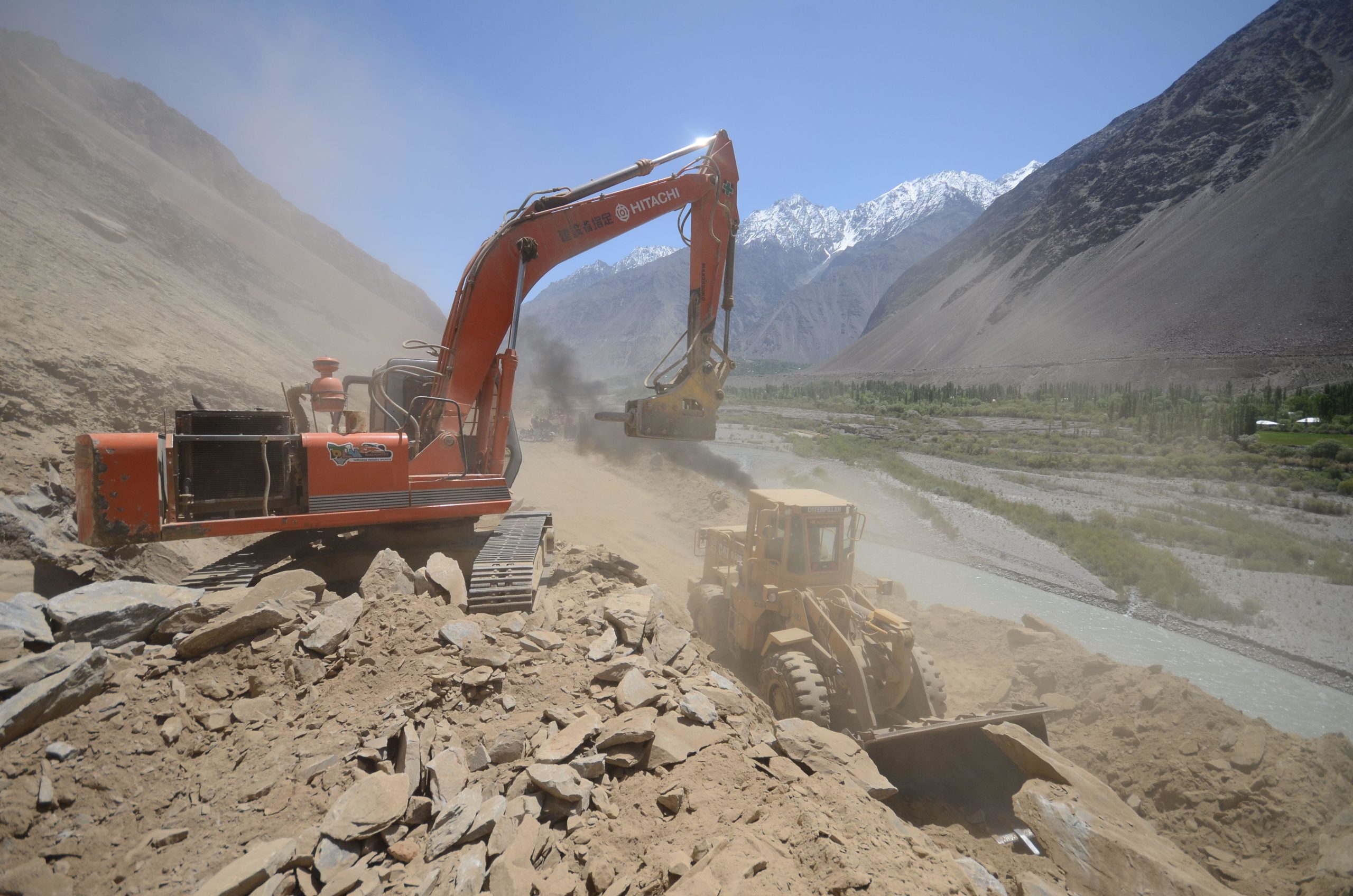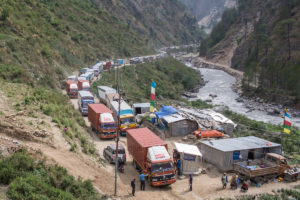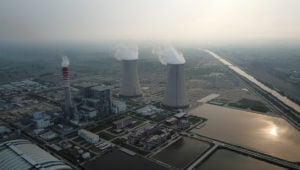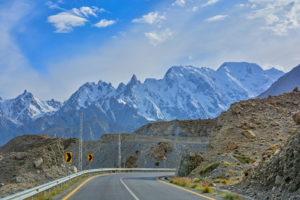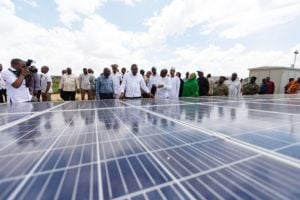“Once the highway becomes a motorway, trucking supplies to Afghanistan will become much faster,” said Shakir Afridi, president of the transport union for Khyber district, in northwest Pakistan’s Khyber Pakhtunkhwa province. Afridi had recently heard that a motorway is to be built between Peshawar and Kabul, going on to Uzbekistan, as part of the China-Pakistan Economic Corridor (CPEC). “It will be good for our business if we can go all the way up to Uzbekistan,” he said.
CPEC started in 2013 as a USD 47 billion bilateral agreement between China and Pakistan to build transport networks, energy projects and special economic zones, financed by China. It has grown to an estimated USD 62 billion. Now, China wants CPEC to be extended to Afghanistan.
This was confirmed by Ahsan Iqbal, Pakistan’s federal minister for planning, development and special initiatives, in an exclusive phone interview to The Third Pole. “This will provide Pakistan a unique opportunity to leverage its geo-location for regional connectivity,” he said.
Afridi’s trucks are among the estimated “3,500 heavy-duty vehicles travelling on Pakistan’s highways and motorways, carrying anything from crockery, garments, cloth, cigarettes and packaged juices from ports in Karachi and Gwadar all the way to Jalalabad [Afghanistan’s fifth-largest city] in four days,” he said.
Regional connectivity will promote economic development for “close to three billion people”Ahsan Iqbal, Pakistan’s federal minister for planning, development and special initiatives
Sophia Nina Burna-Asefi, research associate in the Russia, Eastern Europe and Eurasia team at the consultancy Risk Advisory Group, said the road extension would likely go through the “Wakhan Corridor touching China in the northeast; Pakistan in the south and Tajikistan in the north”, thereby providing Pakistan “the shortest route to Central Asia through Afghanistan”.
“Once in Pakistan, the goods will be offloaded to connect with the Pakistan rail system and from there will eventually travel down to the Pakistani seaports of Karachi, Gwadar and Qasim,” she told The Third Pole.
Of the three ports, “Gwadar will be the shortest and most natural route for trade”, said Mushahid Hussain Sayed, a senator in the Pakistani parliament and founder of the Pakistan-China Institute, a thinktank that promotes bilateral relations.
Zakir Jalali, director-general at the Third Political Department, part of Afghanistan’s Ministry of Foreign Affairs, spoke to The Third Pole in August. He had just returned from Tashkent in Uzbekistan, where he had been discussing connectivity issues with officials from Uzbekistan and Pakistan. Beside roads, he said, “a railway line will be constructed from Termez in Uzbekistan to Mazar-e-Sharif via Kabul in Afghanistan, to Peshawar in Pakistan. The field survey for the railways has already begun in Uzbekistan.” The 573-kilometre track was first proposed in 2018 by Uzbekistan.
An opportunity for the Central Asian republics?
“CPEC is an opportunity for Uzbekistan, which is landlocked, to expand to non-traditional markets and diversify its supply routes,” said Burna-Asefi. From the new deep sea port of Gwadar, Uzbek goods could be transported anywhere in the world.
Sayed, the senator, said that as well as Uzbekistan, Tajikistan, Turkmenistan, Kyrgyzstan and Kazakhstan have shown interest.
Laying down more infrastructure in Afghanistan would help Pakistan reorient its foreign policy toward a more geoeconomics-focused end goalMichael Kugelman, Wilson Center
This regional connectivity would also fulfil the aim of China’s Belt and Road project of “integrating new markets across the length and breadth of the region, through rail and road connectivity,” said Iqbal, the minister. He added that it would promote economic development for “close to three billion people in Pakistan, Afghanistan, China and the Central Asian republics”.
“Pakistan hopes to reorient its foreign policy toward a more geoeconomics-focused end goal, and that entails more trade links and connectivity with Afghanistan and Central Asia,” said Michael Kugelman, director of the South Asia Institute at the Wilson Center in Washington, DC, and a leading specialist on Afghanistan. “Laying down more infrastructure in Afghanistan would help in this goal,” he said.
Trans-Afghan rail link
Along with an Uzbekistan-Afghanistan-Pakistan rail link, Afghan minister Jalali said, “Russia, too, is interested in being part of a five-country rail link between Kazakhstan, Uzbekistan, Afghanistan and Pakistan.”
USD 5 billion
Estimated cost of the Trans-Afghan Railway
Over the past year, Moscow has been making diplomatic and political overtures to improve ties with the Taliban regime and increase its leverage in Afghanistan.
Beijing’s relations with Moscow have become stronger and the former may want new collaborations with Russia in Central Asia, said Kugelman. “This is easier to envision with new Chinese infrastructure projects in neighbouring Afghanistan,” he said.
At the same time, he said, Pakistan is keen to pre-empt India’s own inroads into Central Asia. “New Delhi also seeks to ramp up relations with the region, and its recent decision to reopen its embassy in Kabul is an indication of its desire to facilitate access to Central Asia,” said Kugelman.
For Afghanistan, for now, Jalali said he hoped that “infrastructure development will open enormous livelihood avenues for our people”. Afghanistan has good relations with China, and is hesitantly mending fences with Pakistan. Jalali said the country is ready to welcome CPEC’s extension to Afghanistan as “it had wanted to be part of China’s BRI”.
In fact, the Afghan official said, regional connectivity and economic integration is part of its soon-to-be-launched foreign policy.
Where is the money?
The big question, however, is how will the resource-starved Afghan government be able to finance the different connectivity projects?
According to news reports, several financial institutions including the World Bank, the Asian Development Bank, the European Bank for Reconstruction and Development, the Islamic Development Bank and the Asian Infrastructure Investment Bank have expressed interest, but have not committed to the estimated USD 5 billion Trans-Afghan Railway.
Obviously Afghanistan has no money but it can provide the manpower. Our neighbours can invest in our infrastructure now and reap benefits for years to come.Zakir Jalali, Afghanistan’s Ministry of Foreign Affairs
With USD 7 billion of Afghan assets currently frozen in US banks, Burna-Asefi surmised the financing would “most likely come from the countries that are party to the project”.
“Obviously Afghanistan has no money but it can provide the manpower. Our neighbours can invest in our infrastructure now and reap benefits for years to come,” said Jalali.
According to Burna-Asefi, “Beijing is also attracted to Afghanistan’s unexplored resources and securing rare earths”. In 2010 the value of Afghan mineral resources was assessed at USD 1 trillion by the US government; it is unclear how much they are worth now.
“China has long eyed Afghanistan’s raw materials,” agreed Kugelman, but said it has held back because of security concerns. Describing rare earth exploitation as “a long shot”, Sayed said that until peace was assured, China would not want to go in that direction.
Security issues
Security issues loom large and, with Pakistan’s economy in free fall, Kugelman said that the time was not right “to be thinking about ambitious, long-term connectivity projects next door”.
The worsening security situation makes it difficult for Afghanistan “to secure a credit line with financial institutions”, said Burna-Asefi.
“For China, safety and security will take precedence over economic activity,” predicted Sayed. The presence of the Tehrik-i-Taliban Pakistan, the East Turkestan Islamic Movement (a Uyghur Islamic extremist organisation founded in western China), the Islamic State of Iraq and the Levant (also known as ISIS or Daesh) and Al-Qaeda in Afghanistan continue to cast a cloud over regional development.
Without stability in Afghanistan, “China, can invest [a little] and make long-term promises, but won’t budge beyond this,” said Burna-Asefi.
Kugelman agreed with Sayed and Burna-Asefi. “[China] would not want to be burdened by the financial responsibilities” and will remain “cautious” in Afghanistan, he said.
But this wariness failed to dampen Iqbal, who dismissed these concerns, saying “there is no security issue whatsoever”.
Environmental cost
Another question hanging over the project is its environmental impact and climate resilience. While CPEC has a stated aim to pursue clean energy projects, much of it has been cement, steel and coal-intensive infrastructure in Pakistan. The construction of railway lines and the road into Afghanistan as part of CPEC’s extension may mean more of the same. “Afghanistan, like all of South Asia, is acutely vulnerable to climate change effects, including drought. There’s reason to worry that intensive new development projects could further exacerbate Afghanistan’s water insecurity,” pointed out Kugelman.
Writing in The Diplomat in July, Burna-Asefi highlighted the topographic challenges, including one route envisioned through the Salang Pass at an altitude of 3,500 metres. “This would make it one of the highest railway lines in the world. The Salang Pass is prone to heavy snowfall and/or avalanches during the winter season, which could disable the railway for extended periods,” she wrote.
The floods should be a wake-up call for Pakistan and for all of the CPEC projectsAhmad Rafay Alam, environmental lawyer
Pakistan’s recent catastrophic flooding has brought home the need to assess climate and environmental factors in the region. However, commentators have long pointed out that CPEC projects have rarely considered these.
“The floods should be a wake-up call for Pakistan and for all of the CPEC projects, including the ones that will be taken up in Afghanistan, [that they] must minutely and stringently carry out honest environmental assessments of big projects,” environmental lawyer Ahmad Rafay Alam told The Third Pole.
